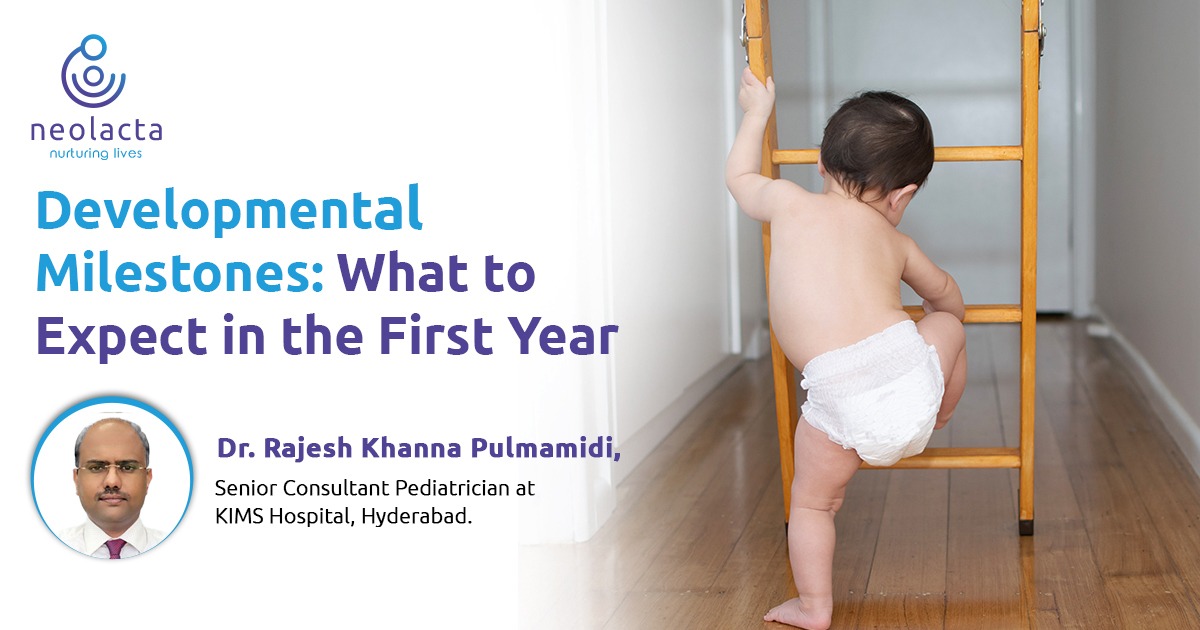Developmental milestones encompass a set of skills and goals that children are expected to achieve as they grow.
We recently conducted an exclusive Instagram Live session with Dr. Rajesh Khanna Pulmamidi, a renowned Senior Consultant Pediatrician at KIMS Hospital, Hyderabad. This blog consolidates the key insights and discussions from that live session.
Activities like rolling over, crawling, walking, talking serve as examples of these milestones for babies. Monitoring these milestones allows doctors to assess whether a child is following a typical growth trajectory. If a child is unable to reach these milestones by the expected age, intervention may be necessary to help them reach their full potential. This monitoring is also valuable in identifying developmental disorders like Autism Spectrum Disorder , Cerebral Palsy, or Attention Deficit Hyperactivity Disorder.
These developmental milestones can be categorised into
- Motor skills – Gross and Fine
- Social/Emotional milestones
- Language milestones
- Cognitive milestones
Motor skills
These physical milestones are achieved by babies after birth, and they typically progress from head to toe. The first skill in this sequence is head-holding. Newborns have little muscle tone or neck strength , which is why it’s always recommended to support their neck when holding them. By the second or third month of their life, they can usually hold their heads up on their own. Gradually,they develop the ability to lift both their heads and chests .
During this time, babies also develop a strong grip, enabling them to open and close their hands. Within the next 4-6 months ,they start pushing themselves up on their hands and begin to learn how to roll over. Their hand grip continues to improve , allowing them to reach out , grab objects, and transfer them from one hand to the other.
Around the age of 6 months, with some support ,babies can sit upright and start exploring the use of their fingers and thumbs. In the following 3 months ,they can enter the crawling stage, attempting to climb or crawl on stairs. They also develop the use of the pincer grasp , using their forefinger and thumb to pick up small objects. This is a significant milestone as it forms the foundation for various daily activities like feeding, buttoning clothes, holding a pencil.
By the age of 10 months, their leg strength has improved to the point where they can pull themselves up to a standing position.
They can also stack and sort their toys and confidently push their hands through sleeves while dressing up.
Social/Emotional Milestones
Social/Emotional milestones provide valuable insights into a child’s personality development and their ability to form attachments and relationships with others. During the first few months of life, infants begin to engage in crucial social interactions. They learn to track your movements with their eyes, respond with smiles, and even attempt to mimic your expressions, such as laughter or crying.
By the time they reach 6 months of age, infants can recognize familiar faces, including family members and friends. They exhibit signs of separation anxiety , often crying when a parent or caregiver leaves the room. In the ensuing months, they become more attuned to other people’s emotions or expressions, paving the way for interactive games like peek-a-boo.
As they approach their first birthday, children continue to reach significant social and emotional milestones. They can express their food preferences, showcasing their budding individuality. Furthermore, they start comprehending cause-and-effect relationships, experimenting with your reactions to actions like dropping a spoon. In addition to this, they begin to imitate your actions, such as pretending to answer the phone.
These social and emotional milestones mark important stages in a child’s development, demonstrating their growing ability to connect with and understand the world around them.
Language Milestones
Language development plays a vital role in an individual’s growth and development as it serves as the cornerstone of communication. It enables individuals to express themselves, understand others, and enhances a child’s cognitive abilities. This journey begins with cooking, which typically emerges by the third month of life. Around 6 months of age, babies start to laugh heartily and engage in babbling.
As they continue to mature, infants begin to respond to familiar words and may turn their attention when they hear their name. By 11-12 months, they start using single words like “mama” and “dada”. This progression evolves into the use of 2-3 phrases and short sentences as they further develop.
It’s worth noting that to facilitate effective communication, it is advisable to focus on teaching one language until the age of 2 years . This approach helps establish a strong foundation in language skills. Parents can then choose to introduce multiple languages if they desire to do so, building upon this solid linguistic base.
Nurturing language development is a crucial aspect of a child’s early years, fostering their ability to interact, express themselves, and engage with the world around them.
Cognitive Milestones
Cognitive development pertains to the growth and development of the brain’s capacity to learn and remember. During the first two months of life, infants begin to exhibit an innate curiosity about the world around them. They learn to turn their heads towards new objects and display longer gazes when presented with complex stimuli.
Around the fourth month, their visual abilities become more refined, allowing them to make sense of their sensory experiences , including taste, sound , and touch . They also begin to explore and interact with their environment, wiggling their fingers and gaining a sense of individuality. This period is marked by their growing ability to recognize familiar sounds and people.
Between the ages of 9-12 months, as infants start to observe the world more closely, they become keenly interested in people around them. With the newfound skill of crawling, they actively explore their surroundings, including drawers and cupboards e, in their quest to understand and engage with their environment.
These cognitive milestones reflect a child’s burgeoning intellectual development and their increasing capacity to comprehend and interact with the world as they grow.
These developmental milestones provide a valuable roadmap for a baby’s healthy growth and development. Occasionally, developmental delays may get unnoticed for various reasons, but regular visits to the paediatrician can aid in monitoring these milestones. Identifying any delays early on may serve as an indicator of potential neurodevelopmental disorders, prompting further evaluation. Swift diagnosis and intervention can be instrumental in resolving any underlying issues.
The journey of a baby’s growth during the first year of life is undeniably fascinating , as they embark on the adventure of exploring the world around them. While there may be challenges along the way, it’s important to remember that you are doing your utmost to support your baby’s development. Don’t hesitate to seek help or support wherever needed, and savor every moment of this journey to the fullest.
References
- Baby’s First Year: How Infants Develop, by Gina Shaw, March 27,2022, accessed on Oct1st,2023 https://www.webmd.com/parenting/baby/features/stages-of-development
- Toddler Growth and Development, updated June 21, accessed on Oct 1st, 2023 https://www.healthlinkbc.ca/pregnancy-parenting/parenting-toddlers-12-36-months/toddler-growth-and-development/cognitive-0
- Misirliyan SS, Boehning AP, Shah M. Development Milestones. In: StatPearls. Treasure Island (FL): StatPearls Publishing; March 16, 2023.


